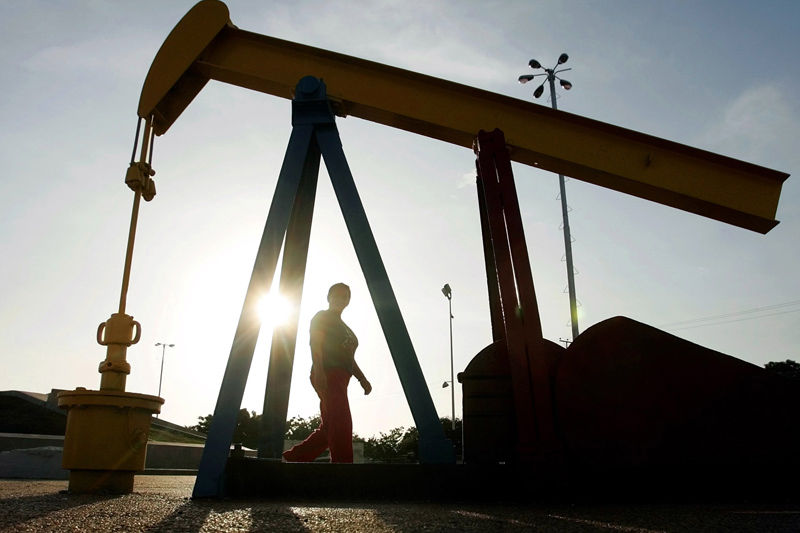Investing.com - Crude oil futures fell in Asian trading on Wednesday on talk the U.S. government will dip into its strategic petroleum stockpiles in an effort to lower prices at the gasoline pump.
On the New York Mercantile Exchange, light, sweet crude futures for delivery in May traded at USD106.89 a barrel, down 0.41%, down from a session high of 107.06 and up from an earlier session low of USD106.71.
High oil prices have sent gasoline prices surging in the U.S. this election year, with the nationwide average for a gallon of regular gasoline hovering around USD3.90 a gallon, according to the American Automobile Association's Daily Fuel Gauge Report.
Tensions between the West and Iran are sending crude prices higher ahead of normal spikes that arrive in the U.S. spring and summer, when more motorists hit the road and also when refineries switch to more expensive inputs.
Talk that the government will dip into Strategic Petroleum Reserve to increase supply and lower prices at the pump during an election year sent oil falling early Wednesday in Asia.
Mention of such policy is growing, as a few weeks ago reports emerged that the U.S. and the U.K. were considering a coordinated move to boost supply by tapping emergency supplies, although neither government would confirm the move.
Reports that Iran may be willing to speak with western negotiators over its nuclear standoff allowed oil to slump as well
Soft economic indicators in the U.S. didn't help crude either.
The Conference Board reported that its closely watched consumer confidence index slipped to 70.2 in March from a revised 71.6 in February, slightly worse than an expected reading of 70.3.
Meanwhile, the Standard & Poor’s/Case-Shiller U.S. house price index fell at an annualized rate of 3.8% in January from a year earlier, meeting expectations although the reading shows that home prices continue falling.
Fed Chairman Ben Bernanke this week has said he cannot rule out resorting to fresh stimulus measures to jolt more life in the economy, which was bullish for the commodity although markets began to brush U.S. monetary policy off by Wednesday in Asia.
Still, the market will continued to keep an eye out for hints of a new round of quantitative easing in the U.S. to stimulate the economy.
Under quantitative easing the Federal Reserve buys assets from banks, flooding the economy with liquidity in the process to encourage hiring and steer the country away from a deflationary spiral, with the dollar weakening in the process.
Oil often rises under such a scenario, as the ensuing rush of liquidity finds its way into dollarized commodities, where buyers in other currencies snap up suddenly cheaper raw materials.
On the ICE Futures Exchange, Brent oil futures for May delivery were down 0.20% and trading at USD125.11 a barrel, up USD18.22 from its U.S. counterpart.
The gap in price between the two contracts is pushing close to a nearly USD20.00 all-time high and a historical spread of USD1.00.
On the New York Mercantile Exchange, light, sweet crude futures for delivery in May traded at USD106.89 a barrel, down 0.41%, down from a session high of 107.06 and up from an earlier session low of USD106.71.
High oil prices have sent gasoline prices surging in the U.S. this election year, with the nationwide average for a gallon of regular gasoline hovering around USD3.90 a gallon, according to the American Automobile Association's Daily Fuel Gauge Report.
Tensions between the West and Iran are sending crude prices higher ahead of normal spikes that arrive in the U.S. spring and summer, when more motorists hit the road and also when refineries switch to more expensive inputs.
Talk that the government will dip into Strategic Petroleum Reserve to increase supply and lower prices at the pump during an election year sent oil falling early Wednesday in Asia.
Mention of such policy is growing, as a few weeks ago reports emerged that the U.S. and the U.K. were considering a coordinated move to boost supply by tapping emergency supplies, although neither government would confirm the move.
Reports that Iran may be willing to speak with western negotiators over its nuclear standoff allowed oil to slump as well
Soft economic indicators in the U.S. didn't help crude either.
The Conference Board reported that its closely watched consumer confidence index slipped to 70.2 in March from a revised 71.6 in February, slightly worse than an expected reading of 70.3.
Meanwhile, the Standard & Poor’s/Case-Shiller U.S. house price index fell at an annualized rate of 3.8% in January from a year earlier, meeting expectations although the reading shows that home prices continue falling.
Fed Chairman Ben Bernanke this week has said he cannot rule out resorting to fresh stimulus measures to jolt more life in the economy, which was bullish for the commodity although markets began to brush U.S. monetary policy off by Wednesday in Asia.
Still, the market will continued to keep an eye out for hints of a new round of quantitative easing in the U.S. to stimulate the economy.
Under quantitative easing the Federal Reserve buys assets from banks, flooding the economy with liquidity in the process to encourage hiring and steer the country away from a deflationary spiral, with the dollar weakening in the process.
Oil often rises under such a scenario, as the ensuing rush of liquidity finds its way into dollarized commodities, where buyers in other currencies snap up suddenly cheaper raw materials.
On the ICE Futures Exchange, Brent oil futures for May delivery were down 0.20% and trading at USD125.11 a barrel, up USD18.22 from its U.S. counterpart.
The gap in price between the two contracts is pushing close to a nearly USD20.00 all-time high and a historical spread of USD1.00.
